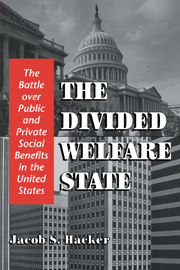Book contents
- Frontmatter
- Contents
- List of Tables
- List of Figures
- Preface
- Part I The American Welfare Regime
- Part II The Politics of Public and Private Pensions
- Part III The Politics of Public and Private Health Insurance
- Part IV The Formation and Future of the American Welfare Regime
- 6 The Formation of the American Welfare Regime
- 7 The Future of the American Welfare Regime
- Appendix
- Notes
- Index
7 - The Future of the American Welfare Regime
Published online by Cambridge University Press: 05 June 2012
- Frontmatter
- Contents
- List of Tables
- List of Figures
- Preface
- Part I The American Welfare Regime
- Part II The Politics of Public and Private Pensions
- Part III The Politics of Public and Private Health Insurance
- Part IV The Formation and Future of the American Welfare Regime
- 6 The Formation of the American Welfare Regime
- 7 The Future of the American Welfare Regime
- Appendix
- Notes
- Index
Summary
The battle over the boundaries between public and private social provision is among the oldest in American political history. Even before the rise of large-scale public and private social policies, Americans debated whether social welfare duties should be carried out by government or instead be left to community, family, or individual. The growth of public social programs and, alongside them, of publicly encouraged private social benefits manifested successive resolutions of this struggle, but it did not settle the dispute. Barriers to public action fell, new roles for the state and private sector came to be accepted, and powerful constituencies and institutions rose up around these roles. But where the lines would be drawn and in what way still prompted simmering conflict, which, repeatedly and sometimes violently, burst into boil.
Still, for much of the postwar period, it seemed that a rapprochement of sorts had been reached. Skirmishes took place on the frontiers of the American welfare regime – over national health insurance most prominently, but also over the scope of Social Security. Yet away from the front, the respective fields of both public and private benefits were secure and relatively accepted. The steady growth of both public and private benefits, the degree to which their development set in motion self-reinforcing political processes, and the extent to which the two spheres were intertwined all encouraged political actors to accommodate themselves to the basic policy framework already in place.
- Type
- Chapter
- Information
- The Divided Welfare StateThe Battle over Public and Private Social Benefits in the United States, pp. 313 - 336Publisher: Cambridge University PressPrint publication year: 2002

